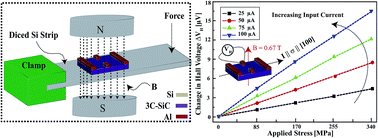Piezo-Hall effect in single crystal p-type 3C–SiC(100) thin film grown by low pressure chemical vapor deposition
Abstract
This article reports the first results on piezo-Hall effect in single crystal p-type 3C–SiC(100) Hall devices. Single crystal p-type 3C–SiC(100) was grown by low pressure chemical vapor deposition, and Hall devices were fabricated using the conventional photolithography and dry etching processes. An experimental setup capable of applying stress during Hall-effect measurements was designed to measure the piezo-Hall effect. The piezo-Hall effect is quantified by directly observing the variation in magnetic field sensitivity of the Hall devices upon an applied stress. The piezo-Hall coefficient P12 characterized by these measurements is found to be 6.4 × 10−11 Pa−1.


 Please wait while we load your content...
Please wait while we load your content...